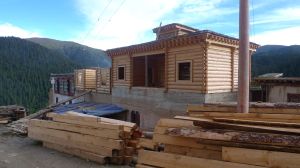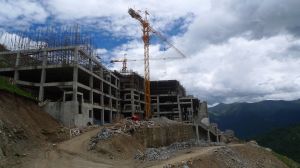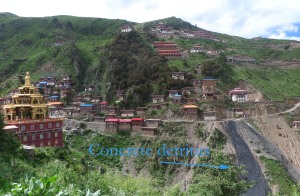


_____________________________________




_____________________________________

Every monastery I visited this summer had some sort of construction project going on. While not all of these were epic in scope, it was hard to escape the idea that Kham is experiencing a boom in monastic construction. I’m sure there are many reasons for this, including new wealth among Tibetans, interest in Tibetan Buddhism among the Han Chinese, tourism revenues, and so forth. That analysis, however, I will leave for others. What I’m more interested in here is the style in which this construction is performed. Basically, I observed two major construction models, ‘traditional’ and ‘concrete’.

Palpung Monastery serves as a great example of the former. Palpung sits on a promontory overlooking the Bei Chu river, a tributary of the Dri Chu. It is a beautiful location, overlooking a wooded valley, and below high, grassy slopes. Miraculously, the main temple hall seems to have survived the Cultural Revolution fairly intact, even though most of the religious artwork and other artifacts were destroyed or removed. When I visited in June, there were several buildings under construction, mostly houses for resident monks (like many traditional monasteries, monks at Palpung reside in their own homes, rather than in collective dormitories). In each instance, the buildings were being constructed using the standard timber construction seen all over the area (see photo 1). With the exception of an electric saw for shaping the beams, there were no modern construction methods in evidence. Importantly, the construction work did not negatively interfere with the life of the monastery, and no one I spoke with seemed bothered by the activity. (For more on the architecture, art and conservation measures at Palpung, visit the Palpung Architecture Project)

This contrasts with Katok Monastery, which typifies the ‘concrete’ construction style. At Katok, there were no less than three major construction projects going on simultaneously. Each of these buildings required large numbers of dump trucks, concrete mixers and workers. While I’m sure that the results will be impressive, the current situation can only be described as chaotic and dirty. In his Footprint Tibet guidebook, Gyurme Dorje extols the serenity of Katok monastery, saying, “Anyone viewing the majestic setting of Katok’s red and white buildings which cover the peaceful mountain top can appreciate why the concept of ‘sacred outlook’ or ‘pure visionary perception of the landscape’ is so significant here.”[1]

While this may have been true in the past, Katok monastery’s peaceful mountaintop is currently dominated by construction noise. An entire hillside has been turned black by detritus poured out by a continuous stream of dump-trucks (see photo 3). Arriving here after the peace of Palpung, the activity, dirt and noise was quite a shock. Furthermore, I was not the only one who objected to all the activity: several of the monks I spoke with also expressed distaste at what was going on, even questioning the need for the new buildings at all. Looking at the black debris on the hillside, one monk commented, “Nothing will grow there again.” Like many monasteries, Katok does not have a clear hierarchical structure with a single head. Instead, different lamas are each responsible for their own sections of the monastery. In the case of Katok, this seems to have lead to competing construction projects, with little regard for the overall impact on the monastery or its environment. To be fair, timber construction has its own environmental problems. All those trees have to come from somewhere, and even in pre-modern times, deforestation was a real issue in Kham. Still, the difference between the construction and its attendant environmental issues at Palpung and Katok is striking, and I can’t help but feel like there must be a better way to do this.
Katok is not alone in choosing concrete over more traditional construction methods. Almost every monastery I visited had some form of construction work going on, and most were employing concrete construction methods (Karndzé Nunnery is another notable exception. The new Chenrezik temple there was being built entirely with traditional stonework). Of course, as a tourist, it is easy to praise the beauty of traditional construction and denigrate modern techniques. The monks who live in these monasteries, however, may appreciate the conveniences provided by modern construction (such as, say, basic plumbing). Nevertheless, it seems like something has been lost when an already significant monastery, like Katok, dedicates so much capital to a project, only to damage its own environment in the process.
Notes:
_____________________________________
[1]Dorje, Gyurme. Footprint Tibet. 3rd ed. Footprint, 2004, p 494.

I’m now two weeks into my first trip to Tibet in three years. Many things are the same, but many are different. Last time I was in this region of Kham, I remember being struck by several huge mani mantras inscribed across entire hillsides, often in strategic locations above villages or near river confluences. In the intervening three years, these mantras have notably increased in both size and frequency. On the road from Dartsedo to Karndzé it seemed like every village had at least one of these epic endeavors. It is hard to escape the idea that the region’s Tibetans are making a strong statement about the identity of their land.
Of course, this is not the first time that Tibetans have used the construction of religious monuments to claim or alter the identity of their land. If we are to believe Tibetan historical accounts, the importation of Buddhism was only made possible by the construction of twelve temples by the sixth century king Songtsen Gampo. The construction of these temples suppressed a malevolent demoness who had been obstructing Buddhism. By building the temples, the king suppressed the opposing forces and established Tibet as a Buddhist nation.
Nor is such activity limited to the Tibetan Imperium. On a smaller scale, it remains common for local Tibetan communities to deal with malevolent spirits by erecting prayer flags or a small chörten. As with Songtsen Gampo’s temples, these constructions effectively overcome whatever was polluting or obstructing the area, restoring its proper Buddhist identity.

It is not surprising, after the events of the last half century, that Tibetans here would feel a need to re-assert the Buddhist (and thereby Tibetan) nature of their land. Nor, I suppose, should it be surprising that the pace of that activity has increased since 2008 (in addition to the new hillside manis, I saw three large chörtens under construction between Dartsedo and Karndzé as well as numerous new prayer flag arrays and smaller chörtens). Nevertheless, these constructions, and the sentiments they represent, seem worth noting for those of us who try to keep our fingers on Tibet’s pulse.
[Added 7/8/2010]:
As I was leaving Kham, driving from Karndzé to Dartsedo, I noticed a monument I did not see on the way up. It was laid out across a hillside and made out of white stones, just like the large mani mantras discussed above. It was, however, written in Chinese and located directly below a large police station. While I was unable to get a picture, and only had a few seconds to try and read it, I’m pretty confident the first phrase said something along the lines of ‘work hard for a good country’. Apparently, at least some elements in the Chinese government have grasped the importance of marking the landscape in this way, and have decided to get in on the act!
Sorry about the poor photos, most were taken from moving vehicles!
Suggested Reading:
I heard a story recently that I thought was worth passing on. I have no idea if it is true, but I like it anyway.

In 1903, President Teddy Roosevelt went on a train trip across the country, visiting notable scenic spots. In California, he visited Yosemite, where he met John Muir. Apparently they took a liking to each other. A dinner was planned in their honor at the Wawona lodge. Before the dinner, the two told Roosevelt’s staff that they were going for a walk in Mariposa grove. They didn’t tell the staff that they weren’t coming back that evening.
And so the founder of the conservation movement and the founder of the National Park system managed to give the secret service and everyone else the slip, and spend three days together in the woods. No tents or other gear, just conversation and the biggest trees on earth.
True or not, its a pretty good story.